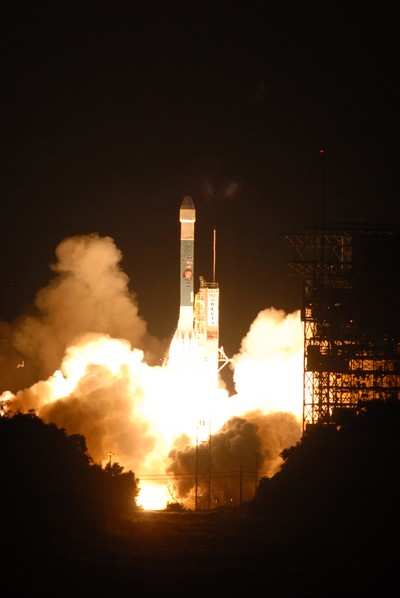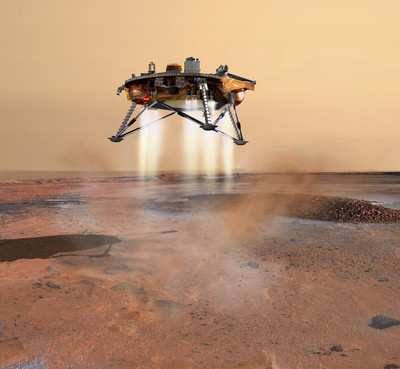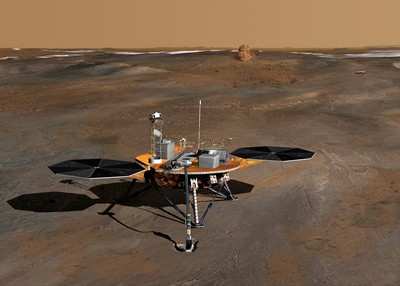Phoenix Rises!
NASA's Phoenix Mars Mission blasted off early Saturday morning,
aiming for a May 25, 2008 arrival at the Red Planet and a close-up
examination of the surface of the northern polar region.

Perched atop a Delta II rocket, the spacecraft left Cape
Canaveral Air Force Base at 0526 EDT into the predawn sky above
Florida's Atlantic coast.
"Today's launch is the first step in the long journey to the
surface of Mars. We certainly are excited about launching, but we
still are concerned about our actual landing, the most difficult
step of this mission," said Phoenix Principal Investigator Peter
Smith of the University of Arizona's Lunar and Planetary
Laboratory, Tucson.
The spacecraft established communications with its ground team
via the Goldstone, CA antenna station of NASA's Deep Space Network
at
0702 EDT, after separating from the third stage of the launch
vehicle.
"The launch team did a spectacular job getting us on the way,"
said Barry Goldstein, Phoenix project manager at NASA's Jet
Propulsion Laboratory, Pasadena, Calif. "Our trajectory is still
being evaluated in detail; however we are well within expected
limits for a successful journey to the red planet. We are all
thrilled!"
Phoenix will be the first mission to touch water-ice on Mars.
Its robotic arm will dig to an icy layer believed to lie just
beneath the surface. The mission will study the history of the
water in the ice, monitor weather of the polar region, and
investigate whether the subsurface environment in the far-northern
plains of Mars has ever been favorable for sustaining microbial
life.

"Water is central to every type of study we will conduct on
Mars," Smith said.
The Phoenix Mars Mission is the first of NASA's competitively
proposed and selected Mars Scout missions, supplementing the
agency's core Mars Exploration Program, whose theme is "follow the
water." The University of Arizona was selected to lead the mission
in August 2003 and is the first public university to lead a Mars
exploration mission.
Phoenix uses the main body of a lander originally made for a
2001 mission that was cancelled before launch.
"During the past year we have run Phoenix through a rigorous
testing regimen," said Ed Sedivy, Phoenix spacecraft program
manager for Lockheed Martin Space Systems, Denver, which built the
spacecraft. "The testing approach runs the spacecraft and
integrated instruments through actual mission sequences, allowing
us to asses the entire system through the life of the mission while
here on Earth."

Samples of soil and ice collected by the lander's robotic arm
will be analyzed by instruments mounted on the deck. One key
instrument will check for water and carbon-containing compounds by
heating soil samples in tiny ovens and examining the vapors that
are given off. Another will test soil samples by adding water and
analyzing the dissolution products. Cameras and microscopes will
provide information on scales spanning 10 powers of 10, from
features that could fit by the hundreds into a period at the end of
a sentence to an aerial view taken during descent. A weather
station will provide information about atmospheric processes in the
arctic region.
 Aero-News: Quote of the Day (04.28.25)
Aero-News: Quote of the Day (04.28.25) ANN's Daily Aero-Term (04.28.25): Decision Altitude (DA)
ANN's Daily Aero-Term (04.28.25): Decision Altitude (DA) ANN's Daily Aero-Linx (04.28.25)
ANN's Daily Aero-Linx (04.28.25) Airborne-Flight Training 04.24.25: GA Refocused, Seminole/Epic, WestJet v TFWP
Airborne-Flight Training 04.24.25: GA Refocused, Seminole/Epic, WestJet v TFWP Aero-News: Quote of the Day (04.29.25)
Aero-News: Quote of the Day (04.29.25)





